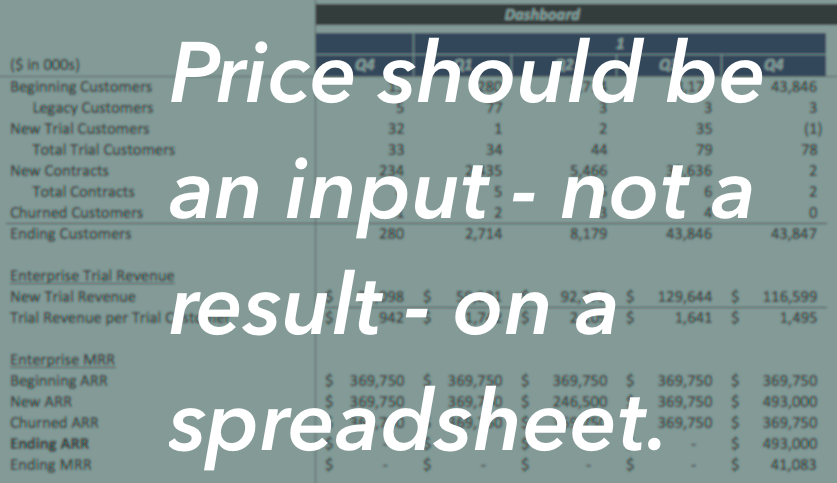 First thing to clearly understand when developing your SaaS pricing strategy; pricing is a function of Marketing.
First thing to clearly understand when developing your SaaS pricing strategy; pricing is a function of Marketing.
If you think creating your SaaS pricing strategy is a function of Finance, Accounting, Operations, or even Sales… you’re doing it wrong.
That means anyone who comes up with a price for their app (or for your app) as the result of a spreadsheet function is doing it wrong.
The spreadsheet shouldn’t tell you what your price is… your price should be something you put into the spreadsheet that will determine revenue and allow you to calculate future growth, profitability, etc.
Price should be an input, not a result, on a spreadsheet.
Second thing to clearly understand:
No one knows what the best price for your SaaS offering should be.
This is why most ‘Pricing experts‘ like to deal with companies that sell commodity products – including traditional software – in markets driven (downward) by pricing.
Value Pricing a SaaS offering, on the other hand, is a completely different beast where you’re often dealing with a completely new and/or heavily differentiated value proposition and very often – with entirely new categories of service offerings!
All we can do is get it AS RIGHT AS POSSIBLE out of the gate and understand that pricing is not a “set it and forget it” function, but – just as your overall Marketing Strategy is ever-evolving and changing with market forces, market feedback, etc.
Now there are techniques, tricks, voodoo dances, and smoke-n-mirror performances one can employ while coming up with your initial price that can help you get closer to that ‘getting it as right as possible.’
SaaS Pricing Strategy: Consider the Customer First
But let me be very clear; any techniques/strategies that don’t take the CUSTOMER into consideration as the main input when developing a price is not going to get you close to where you need to be.
There are so many ways to mess up pricing that the chances of you getting it close to right are not in your favor, even if you employ many of the tricks of the trade.
Fortunately, I don’t employ many of the tricks of the trade… I think ‘the trade’ gets most things wrong so why would I employ their tricks?
But I want to help you get your pricing as right as possible so you don’t leave money on the table… or not too much, at first.
Lead with Value for a profitable SaaS Pricing Strategy
Look, it’s easy to sell cheap stuff… higher prices actually require you to know your customer better!
Remember that customers generally care ONLY about their Desired Outcome and how it affects them (at least when they are searching for a solution).
This means – at first – don’t emphasize features; emphasize OUTCOMES. RESULTS. SUCCESS.
So the definition of Value Pricing is: Applying a price to a service that is congruent with the value derived from the service rather than the underlying cost to create and deliver the SaaS, market prices, specific margins, etc.
Which makes Value Pricing the most effective method of pricing for SaaS and Web Apps… something like cost+margin just doesn’t make sense.
The key to Value Pricing is knowing the, well, value of your service as perceived by your target market AND/OR market segments (not all are alike).
Value is the “What’s In it For Them?” – WIIFT – of your SaaS.
It is the benefit of the benefit of the features… or the emotional benefit. It’s their Desired Outcome.
So a very good way to determine your price – because it requires you to really understand the customer – is to follow the 10x Rule.
“We charge this much because our customers get at least 10x that much value.”
If I sell something for $100, I want to provide at least $1,000 in value to them… at least.
Even better is if the “value” isn’t something that is ‘ROI-able,’ but rather something intangible that they cannot directly quantify.
You do this by understanding your customer’s Desired Outcome, goals, opportunities, problems, etc.
You do this by offering Price Anchors that are not competitive services, but what it would take to replicate this in-house, with low-efficiency, high-cost human beings, what you (or the industry) has paid to create this solution, or the fear of not meeting some level of compliance and the costs associated with that.
And you can remind them – maybe not in so many words – that you must charge a premium price so you have a large enough margin to provide an extraordinary value & experience!
But don’t just remind THEM of that… remember that yourself… charge a premium so you can offer truly PREMIUM service!
Using this method to determine a price will become clear quickly, and you’ll see that delivering a 10x ROI – even if simply perceived by the customer – is rather easy.
In fact, once you start doing this, you’ll see how it can be true that if you charge too little, a 10x ROI isn’t that exciting and how a low price could actually reduce your credibility in the market.


